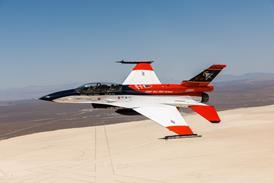When the first Tupolev Tu-144 thundered its way into aeronautical history 50 years ago, lifting off from Zhukovksy airfield on the last day of 1968, much of the supersonic programme remained cloaked by the secrecy of the Cold War.
Flight International first covered the Tu-144’s maiden flight in its second issue of 1969, the first having been dominated by the Apollo 8 space mission.
Such was the limited information available that reportage of this extraordinary Soviet achievement was scant in detail. Flight International stated that the sortie – from an “unidentified” Moscow airport – lasted 38min, having been postponed by bad weather for several days.

Pictured was the prototype airframe, SSSR-68001, and its accompanying heavily-modified Mikoyan-Gurevich MiG-21, the A-144 ‘analogue’ aircraft which featured a similar wing profile to the Tu-144 and no horizontal stabiliser.
Four crew had been on board SSSR-68001 whose flight, according to a brief Soviet statement, had involved a short initial evaluation and systems check and had passed without any significant problems.
The remainder of the Flight International article focused on the uncertainty over whether any UK companies’ equipment had been fitted to the aircraft.
More colour on the event was later provided by test pilot Mark Gallai of strategic bomber developer Myasishchev, which had once drawn up its own supersonic transport proposal. Gallai refers, in a Russian aviation memoir, to Andrei Tupolev’s emerging from a black limousine on 31 December 1968 as the crew of SSSR-68001 waited for persistent fog at Zhukovsky to clear.
Gallai hinted at possible recruitment of meteorological service aircraft which “supposedly knew how to dissipate clouds”, but that a Tu-124 survey jet had indicated better conditions in the air than on the ground. He then described how Tupolev himself demanded a microphone and asked commander Eduard Elyan, in the cockpit, for his opinion.
When Elyan responded that the situation presented difficulties, but that they could be overcome, Gallai said that Tupolev gave the go-ahead to “gently” proceed.
Assigned its own NATO code-name, ‘Charger’, the Tu-144 was as much a symbol of East-West tension as the proclaimed future of air transport, and its maiden flight represented a propaganda coup over its rival, the Aerospatiale-BAC Concorde.
In the same week in which it reported the Tu-144’s becoming airborne, Flight International had, in fact, led its opening news page with an update on Concorde’s progress, stating that its first flight would take place at the end of January or early February 1969. Concorde prototype 001 would not actually fly until 2 March, two months after the Soviet airliner.
The UK government had been dismissive of the Tu-144 at the time. Its Concorde Economic Prospects Committee, in early 1967, had acknowledged the “impressive achievements” of the Soviet Union in certain areas of aerospace technology, but said it had been a “relatively ineffective” rival in the civil airliner sector.
“While therefore we have little hard information on which to base a judgement,” it said, “we have the impression that the Russians would have to make an exceptional technical and commercial effort to render their [Tu-144] a serious competitor with Concorde."
Flight International had received unconfirmed reports that only one prototype would be constructed.
“Any decision on the shape and form of later aircraft will depend on the flight test experience of this aircraft, and on the type and size of [supersonic transport] which the Americans finally decide to build,” it said, a month before the Tu-144’s maiden flight.
The prototype broke the sound barrier on 5 June 1969, says Tupolev. But while it could demonstrate supersonic credentials, its Kuznetsov NK-144 engines could not provide the range required. Tupolev also admitted that the testing showed up other design flaws – excessive vibration and overheating of the aft fuselage.
Subsequent versions of the Tu-144 would, indeed, feature considerable changes from the design of SSSR-68001, with modifications to the wing, engine location, and undercarriage, and the eventual addition of the Tu-144’s characteristic foreplanes.
Source: Cirium Dashboard



















